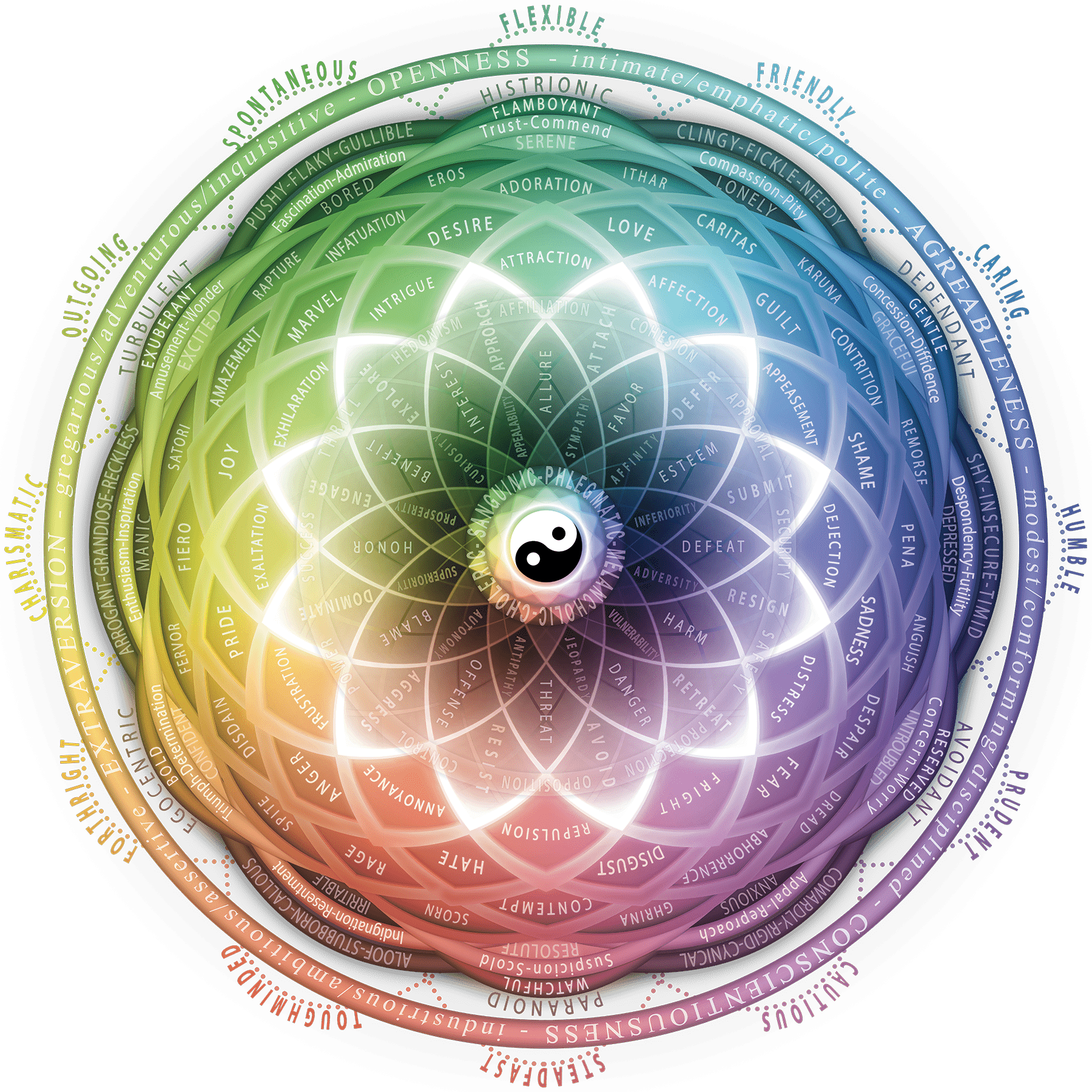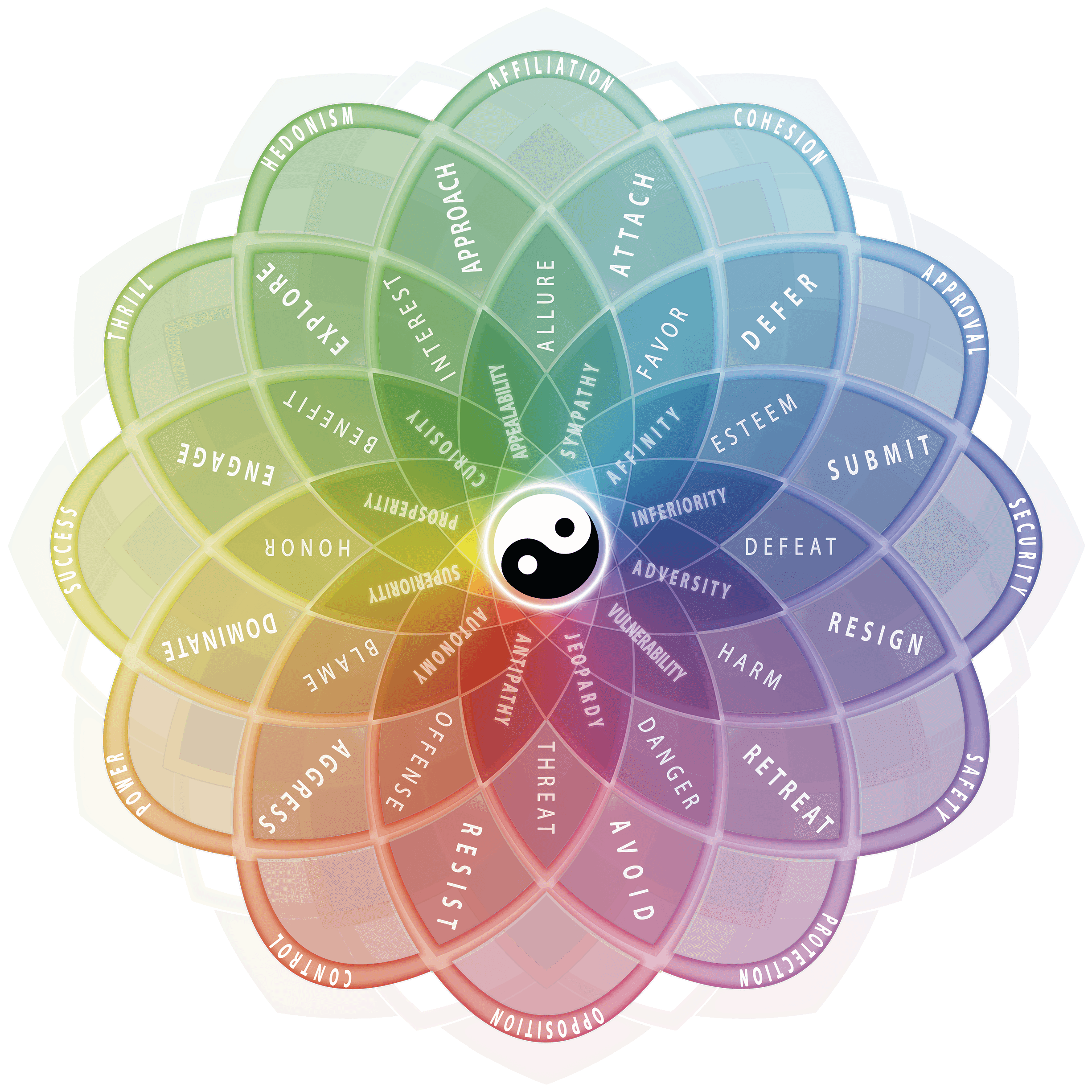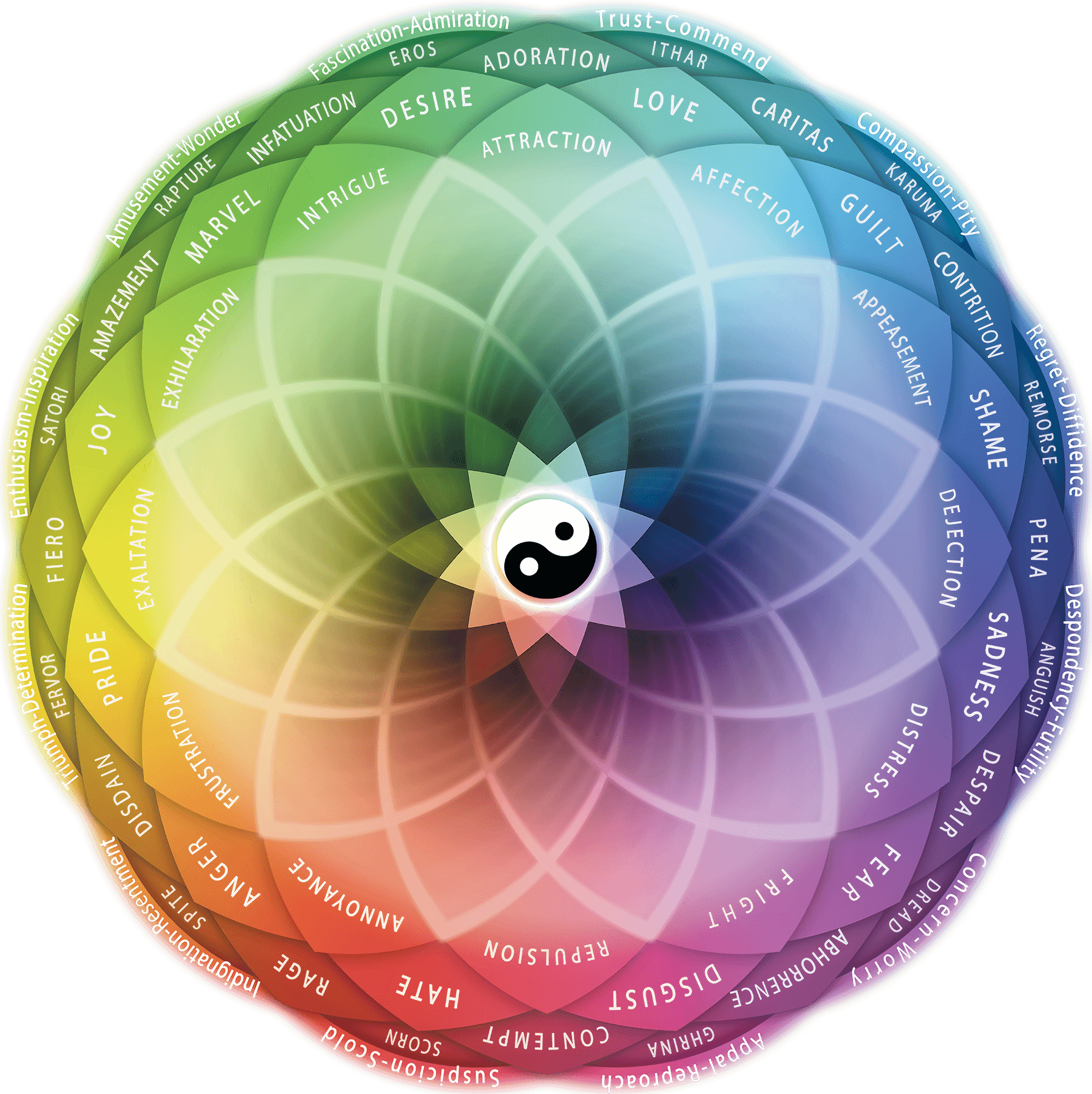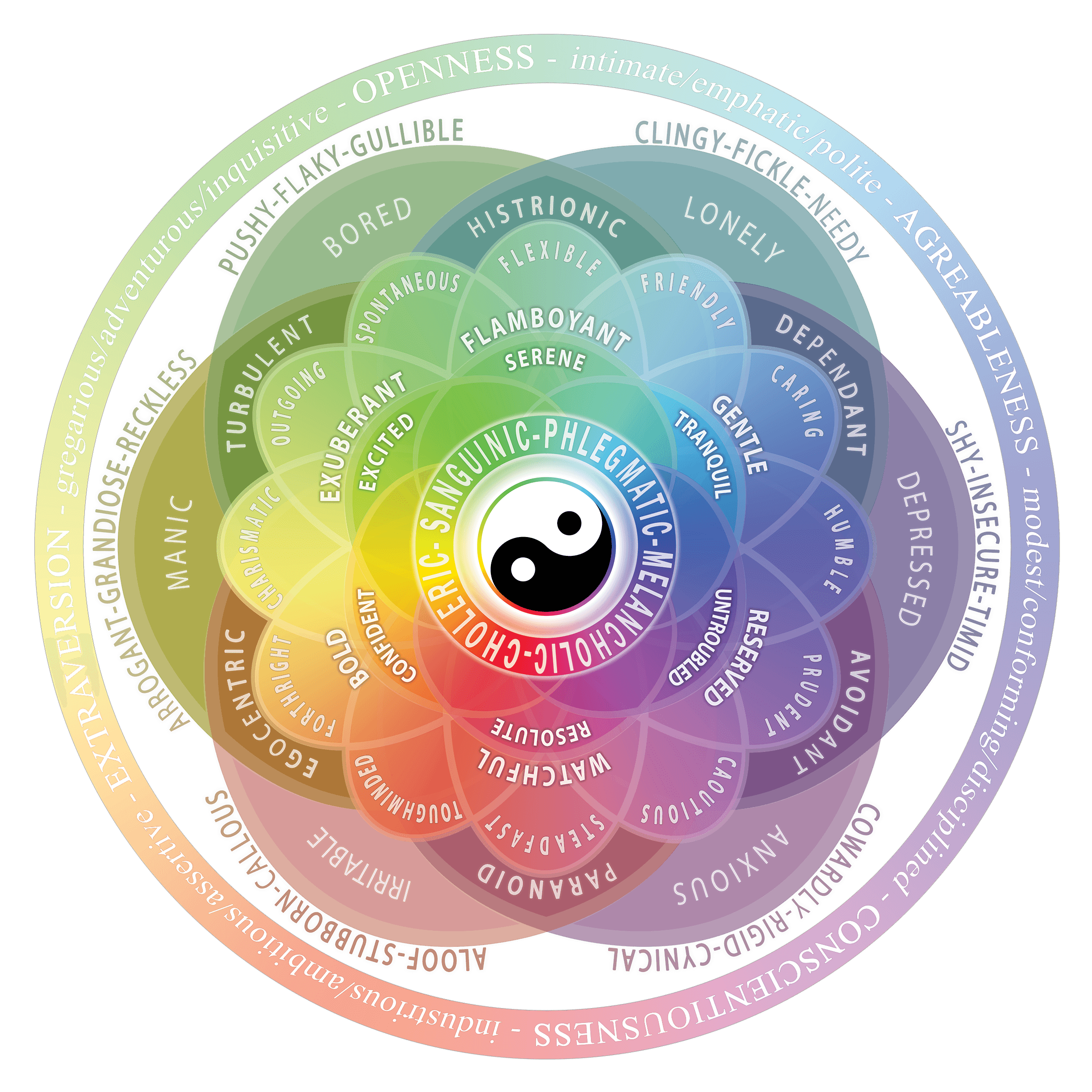An Introduction & TL;DR
You may be someone who encounters this type of learning, which is not instructional, and finds it to be a major setback. Most of us were never taught how to learn from philosophical text, which is unfortunate. If you usually rely on instructions in life, or prefer them because they reduce the time it takes to gain value, the length and difficulty of these texts may seem unproductive or like a chore at first. This is why I am developing a much simplified model to help more people. If you see the value in this type of knowledge but struggle with it, feel free to contact me—my email is at the end of the page. For now, I suggest you either start by reading the texts inside the blue boxes – they’re your guide through this page. Or, click on the various hidden texts in the different parts below for an overview of why this is the best and most practical knowledge you can gain, as well as the theoretical core of the main theory. Integrating the wide array of psychological fields on emotions and the philosophy of mind with its intricate systems has never been attempted to this extent, so I understand any skepticism. I have dedicated my life to understanding the mind and spent at least 10 years developing this model. Now, I am finally confident enough to share it with the world.
PART 1 – Why understanding emotions is vital:
Our emotional intuition constantly learns from the knowledge we get from concepts, and our intuition enables us to construct new concepts from our experience of intuition. What does this mean? It means that what we learn through thought-based understanding helps us construct emotions, and what we emote needs to be understood with the help of thoughts, which themselves are still concepts. This interaction can lead to many errors, as seen in our everyday conflicts. Concepts about emotions influence the development and help with the understanding of emotions experienced! But these concepts can be good, slightly faulty, or outright incompatible with the information our intuitions provide about reality. Sometimes, our intuitions and thoughts are at an impasse; for example, our intuition may signal fright, while our thoughts try to dismiss this and instead build up a sense of triumph to override and transform the intuition into something more manageable, shifting our mood from anxiety to confidence. Often, we do this unconsciously, but we can develop better and more efficient strategies by understanding the underlying causes. This is why the information on this page is so valuable: it helps reduce errors and improves wellbeing, as insight into how our intuition works allows us to choose better strategies and abandon those that fail. Typically, a lack of insight and awareness produces the most mistakes in our social dynamics. We enter conversations with our own biases and may miss the full intentions and deeper meaning behind another’s words. When you understand the theory enough to integrate it into yourself, you must practice restraint because you will see much more in people than they see in themselves. This gives you an edge in conversations, knowing how to respond to achieve your goals—whether building stronger friendships, being likable, advancing in your field, or showing others their faults (which can often be unproductive). If you are talented, you may even become a great psychotherapist, not only for yourself but also for others.
PART 2 – What constitutes emotions:
To understand how our emotions are constructed, we must first learn what emotions are and the main components that form them. Emotions are how intuition communicates vital information about reality—they are a specific type of representation or perception that gives our information value & purpose. Emotions are constructed from content that can be conceptually differentiated into four content nodes: affects, beliefs, impulses, and drives. These elements are tightly connected in the brain and may be difficult to separate.
Beliefs and affects build up through the process of appraisals and provide value for emotions. Affects are the more primitive form of value, while beliefs are the more advanced; both inform us about what is relevant in the current situation. Drives and impulses build up from the process of motivations and define purpose for emotions. Impulses are the more primitive form of purpose, while drives are the more advanced; both inform us about the motives in the current situation.
These components are strongly interconnected. They can produce our underlying mood as a baseline of our being—or, more precisely, our state consciousness—or give rise to emotions through noetic consciousness, sometimes overwhelming us with intuition. Awareness exists on a scale; you can be more or less aware, and these systems determine your level of awareness, displaying it through the strength of your intuitions.
PART 3 – Emotions relate to other perceptions:
Emotions are not a “stand-alone perception”; they are closely related to our instincts, impressions, and judgments. Impressions provide us with information about the world and fuel our emotions. For example, discomfort from cold or heat can influence emotions—the environment and the impressions it creates help determine how we appraise a situation. Although impressions may be similar across individuals, emotional reactions can vary greatly. For example, two people might hear criticism at work (impression/idea)—one becomes anxious and discouraged, while the other becomes excited and hopeful—because their appraisals of the situation are different: one focuses on their flaws as if they are irreparable, while the other sees it as a chance to improve. Instincts also strongly influence emotions; when we are very hungry and our instinct for food satiation is active, we may become more easily frustrated or annoyed. Judgments play a role as well: when we judge a person to be good, we feel more intrigued, attracted, or affectionate, while judging someone as bad can lead to feelings such as fright, repulsion, or annoyance. Consciousness is a continuous flow of different perceptions, and emotions are never isolated from them. Even perceptions themselves overlap with one another, which is why neuroscience has not yet clearly distinguished emotions from other processes. I hope the knowledge I have unified and developed here will help change that.
What this Theory is About
Emotional intuition is the most powerful kind of intuition we have. It’s the invisible force behind those moments that hit you right in the heart. Whenever you shed tears of sadness over something precious you’ve lost or tears of marvel at a profoundly moving experience, you are touching this deep inner sense that shows you the world in a richer, more vivid way. Once you understand how this works, a whole new layer of depth unfolds: your perception sharpens as you’ll start noticing things in yourself and others that you never saw before. You’ll feel more connected, more aware, and more you.
As you explore the homepage, watch for these blue boxes—here you’ll find ongoing commentary and insights that tie each section together, making your journey through this page smoother.
This theory attempts to create a unified framework for understanding emotions by mapping out how different emotional components interconnect and contribute to personality formation, with each concept meticulously positioned in logically precise relationships to others. It aims to bridge the gap between emotional concepts and psychological systems & processes by illustrating the relationships between emotional experiences, personality structures, and the underlying processes that create and maintain them.
Each term and concept is deliberately placed within the framework, with their relationships to other elements carefully mapped according to spatial logical relation, creating a rigorously structured model. Words and concepts in this framework are arranged spatially based on their relationships—the closer two terms appear to each other, the more closely they are related. This creates a structured model where proximity reflects the strength of conceptual connections.
By providing a clear visual representation of these complex relationships, the theory strives to serve both as an accessible entry point for those new to understanding human psychology and as a rigorous conceptual foundation that researchers can use to advance their studies of behavior and consciousness. Essentially, it’s trying to create a logically coherent “map” of how emotions work within the larger system of human personality and the mind.
A Quick Introduction to the Basics
The following categories are interconnected, with some having stronger relationships than others, but none can exist in isolation. Some concepts are more concrete and observable (such as emotions), while others are more abstract and have a more practical purpose (such as dispositions). Each concept helps us better understand both the complete system and its divergent components.
Temperament: The biological foundation for how we process emotions.
Dispositions: Generalizations of probabilities for experience and understanding stemming from temperament and character.
Appraisals & Motivations: Value and purpose processing working together to shape emotions.
Goal Directives: Instructions that turn passive goals into active ones by directing appraisals and motivations.
Passions: Basic, primitive emotions formed from appraisals and motivation that produce what we understand as the feeling part of emotion.
General Emotions: Combined patterns of passions and sentiments shaped by social understanding.
Complex emotions: Are combinations of two or more general emotions that create deeper emotional patterns, a combination of passions and sentiments.
Intricate emotions: Fall under this category as a more advanced form—they emerge specifically from the combination of three general emotions, making them even more nuanced and layered than first-order complex emotions.
Sentiments: Advanced emotions formed from appraisals and motivations that blend thinking and feeling via fantasy.
Moods (Negative and Positive): Mental feeling states reflecting accumulated experiences that influence behavior and prime emotions.
Attitudes (Negative & Positive) : Mental fantasy based states, dependent and correlated with the associated mood, that dictate thoughts and behavior.
Character (Negative & Positive) is the changeable part of personality, that correlates strongest to attitudes and sentiments, capable of regulating temperament.
Personality appears as the final integration, representing how these emotional patterns contribute to broader personality traits. It differs a bit from the standard five factor models (FFM) that modern psychology studies.
Internal Dynamics: How Emotions Arise
These concepts explain how we come to experience emotions, step by step, in the same order shown in the diagram. First, our general traits (dispositions) represent our likelihood to appraise things in a particular way. When we appraise what’s happening, these appraisals promote motivations—our causes for acting. Finally, our goals guide these processes and help fulfill our needs. Understanding this order will help make sense of how our emotions are built.
Psychological DISPOSITIONS are deep-down traits. The concept serves as an overgeneralization of our complete personality and behavior. Think of dispositions as the built-in tendencies we have, shaped by our gene-environment interactions. Everyone needs some kind of internal “instructions” on how to respond to their environment—that’s what dispositions are. In simple terms, a disposition is the likelihood that you will behave a certain way in a specific situation. For example, if you have a natural tendency to be superior or cautious, those are your dispositions. They influence how you perceive, behave, and interpret things. In a nutshell, dispositions help shape your experiences by influencing how you interpret the world and respond to it.
Sympathy, Affinity, Inferiority, Adversity, Vulnerability, Jeopardy, Antipathy, Autonomy, Superiority, Prosperity, Curiosity, Appealability.
Psychological APPRAISALS are the processes by which we evaluate and produce value from the information available to the mind. In terms of emotions, these processes form beliefs and affects, which are essential parts of how emotions are built. Because appraising is a process that happens over time, it changes as new information becomes available, influencing how we (re)construct and experience emotions.
Allure, Favor, Esteem, Defeat, Harm, Danger, Threat, Offense, Blame, Honor, Benefit, Interest.
Psychological MOTIVATIONS are the processes by which we awaken and cultivate purpose from the information available to the mind. In terms of emotions, these processes form our impulses and drives, which are essential parts of how emotions are built. Because being motivated is a process that happens over time, it changes as new information becomes available, influencing how we (re)construct and act on emotions.
Motivations generally follow the appraisal process, as the diagram suggests.
Attach, Defer, Submit, Resign, Retreat, Avoid, Resist, Aggress, Dominate, Engage, Explore, Approach
Psychological GOALS are what you are trying to achieve, often below the surface of your actions. They produce GOAL DIRECTIVES—specific orientations, intentions, or instructions—that are often reinforced by emotions. These goals generally serve as the starting point for emotions, helping activate or enhance the appraisal process by setting priorities and triggering or help start motivations by introducing motives. The diagram illustrates how different dispositions, appraisals, and motivations fall under various goal directives.
Affiliation, Cohesion, Approval, Security, Safety, Protection, Opposition, Control, Power, Success, Thrill, Hedonism.
Peeling back the layers of how emotions are formed is the first step to turning your concept of intuition from a mysterious feeling about what the future holds into a skill you can hone and improve on—just as promised in the beginning.
The Different Types of Emotion
All the words you see in this picture represent different emotions, ranging from simple to complex. Some fundamental emotions are not shown here, but you can view them by clicking HERE. Extremely complex emotions, like envy, jealousy, schadenfreude, hope, and yearning, are also left out because they can’t be easily illustrated in the diagram. The diagram shows the innermost emotions as more feeling-based and closely tied to our biology, while the outermost emotions are more influenced by logic and culture. In between, emotions are a mix of both—closer to the center they are simpler and more basic, and the further out you go, the more they combine both simple and complex emotions.
PASSIONS (basic emotions) are the simplest emotions, as far as they can be separated from other, more complex emotions. Of all the emotions on the diagram, these are the most universal, evolutionary-based and least dependent on culture. The graphic shows how these passions are constantly forming, with new emotional content possibly emerging every second (as exemplified with the spirals between the center and the passions).
Attraction, Affection, Appeasement, Dejection, Distress, Fright, Repulsion, Annoyance, Frustration, Exaltation, Exhilaration, Intrigue.
GENERAL EMOTIONS (generalized emotions) arise as broader patterns that combine two related passions (for example, distress and fright come together to form fear). These general emotions are typically shaped by social and cultural understanding, and people from different cultures often recognize them in similar ways, making them fairly universal. However, the benefits assigned to each emotion can vary, depending on how a particular culture or subculture interprets them (for example, pride or guilt may be viewed positively in some cultures and negatively in others – think Christianity).
Love, Guilt, Shame, Sadness, Fear, Disgust, Hate, Anger, Pride, Joy, Marvel, Desire.
COMPLEX EMOTIONS are a type of general emotion, but they are less universal. Their meanings can change depending on which passions and sentiments are involved, how these are combined, and the specific situations in which they are experienced. They are much more constructed in comparison to passions. Because of this, complex emotions may not be recognized or defined in the same way across different cultures or languages. In the illustration, I have included some emotions that do not have direct equivalents in English.
Less complex: Adoration, Caritas, Contrition, Pena, Despair, Abhorrence, Contempt, Rage, Disdain, Fiero, Amazement, Infatuation.
More complex (intricate emotions): Ithar, Karuna, Remorse, Anguish, Dread, Ghrina, Scorn, Spite, Fervor, Satori, Rapture, Eros.
SENTIMENTS are usually a mixture of thoughts and intuitions. When we experience emotions, we naturally try to understand and describe them using language. We connect these emotions with our thoughts and judgments, creating what I call sentiments. Sentiments are mostly thoughts that shape or interpret our emotions. Unlike passions, sentiments don’t always need to be directly linked to our feelings. For example, trust, inspiration, or resentment can exist as ways of thinking or judging a situation, even if we’re not feeling strong emotions at the moment. In this way, sentiments aren’t pure feelings, but rather thoughtful interpretations based on what we’ve learned from past emotional experiences.
Enthusiasm & Inspiration, Amusement & Wonder, Fascination & Admiration, Trust & Commend, Compassion & Pity, Regret & Diffidence, Despondency & Futility, Concern & Worry, Appall & Reproach, Suspicion & Scold, Indignation & Resentment, Triumph & Determination.
By seeing how all these types fit on a single graph, you’re equipped to better read your own emotional landscape. This is key for refining your emotional intuition: it allows you to recognize where your strongest reactions come from, understand why certain feelings feel deeper or harder to explain, and see how thought and feeling together shape your sense of reality.
The Making of Personality: From Temperament to Character
In the illustration, you’ll notice the inner sections flaunt vibrant, contrasting colors, highlighting the positive aspects of emotional concepts. In contrast, the outer sections display darker, less vibrant hues, indicating more challenging aspects. The inner circle symbolizes effective emotional expression leading to positive outcomes, while the outer represents less effective, negative outcomes. The outermost circle embodies a more neutral, holistic view of personality traits.
TEMPERAMENT is the natural style you’re born with that shapes how you react to the world—some people are naturally more energetic, while others are more calm, recover more quickly, or are more comfortable with change. When we talk specifically about emotional temperament, we’re focusing on how likely you are to feel certain emotions and how intense they tend to be. While temperament can influence many aspects of behavior, in this context, the classic four temperaments are used to describe emotional styles—grouping our typical patterns of experiencing and expressing emotions into four main categories:
Phlegmatic, Melancholic, Choler, Sanguinic.
MOODS are like the background music of your mind, shaping how you experience the world around you. They are embodied manifestations of your accumulated experiences and act as a predictive tool, preparing you for certain emotions by evaluating your environment and guiding your tendencies to act in specific ways. Moods help indicate how favorable the current situation is for particular behaviors or strategies. They arise as a result of specific emotional experiences, and, in turn, make you more likely to feel similar emotions again in the future.
Negative: Bored, Lonely, Depressed, Anxious, Irritable, Manic.
Positive: Serene, Tranquil, Untroubled, Resolute, Confident, Excited.
ATTITUDES are like mental shortcuts we develop about people, ideas, or situations—they are thought-based, much like moods but without always involving feelings. Attitudes help us quickly decide what we like or dislike, and how we should respond. They go hand in hand with moods, just as passions complement sentiments; together, they form the basis for different types of character.
Negative: Clingy, Fickle, Needy; Shy, Insecure, Timid; Cowardly, Rigid, Cynical; Blood, Stubborn, Callous; Arrogant, Grandiose, Reckless; Pushy, Flaky, Gullible.
Positive: Flamboyant, Gentle, Reserved, Watchful, Bold, Exuberant.
CHARACTER is like the moral backbone of who you are; it is built over time through choices, struggles, and life experiences. As the malleable side of personality, character evolves through learning and adaptation, working to regulate or strengthen temperamental tendencies and able to produce behaviors that may seem at odds with innate dispositions. It’s strongly influenced by our environment, personal reflection, and intentional development, reflecting how we interpret, integrate, and express our predispositions in response to life’s demands.
Negative: Histrionic, dependant, avoidant, paranoid, egocentric, turbulent.
Positive: Flexible, friendly, caring, prudent, insightful, cautious, steadfast, toughminded, forthright, courageous, charismatic, spontaneous.
PERSONALITY is your overall style of being—how intuition and thought work together. It develops through gene-environment interactions, with temperament providing the innate foundation of emotional reactivity, and character representing the learned modifications shaped by life experiences. The interplay between these relatively fixed temperamental traits and adaptable character creates consistent yet flexible patterns of behavior. One of the most well-known ways to understand personality is through the Five-Factor Model (FFM), which describes these key dimensions:
– OPENESS – flexible, emphatic, modest – AGREEABLENESS- polite, conforming, cautious – CONSCIENTIOUSNESS- industrious, ambitious, assertive – EXTRAVERSION- gregarious, adventurous, inquisitive – OPENESS
The exception is Neuroticism, which always negatively correlates with the other factors and can be understood through a combination of negative moods and negative character traits, as shown in the illustration. Additionally, as you can see, between each pair of neighboring main factors there are subfactors that seem to best correlate with both; the closer these subfactors are to the main factors, the stronger their correlation.
By understanding how temperament and character work together, you’re not just decoding what makes you “you”—you’re also opening the door to greater awareness and growth. This is the very journey described at the start of this page: as you learn to recognize the roots of your feelings and how they evolve, you unlock the true potential of emotional intuition. With each step, you build a deeper connection to yourself and others, and discover the ability to understand and shape your experience and relationships.
About my Research and Why it Matters
Once you start getting the gist of this theory, the world takes on a new shape. You’ll notice things in people that you never did before, and ideas you thought you understood will gain unexpected depth. Even the knowledge about your emotions you’ve collected throughout life becomes easier to express, and you’ll find it simpler to communicate what you feel. That’s been my own experience: the journey to create this framework has changed me in ways I never imagined, shaped by both the positive and difficult moments in my life.
While I’m confident this work can help anyone struggling with emotions as I did, I also believe it will inspire those who simply want to grow and become more aware of themselves and their social world. I realize that this kind of in-depth learning isn’t for everyone, so I am working on new materials that are more accessible—like simplified guides, clever animations to make each emotion easy to grasp, and personality tests to help you discover your strengths and areas for growth.
My research into personality theory led me down an unexpected but fascinating path. I discovered that understanding personality first required a deeper exploration of human emotions. This exploration, in turn, demanded an investigation into the fundamental workings of the mind, which expanded into a need to complete a comprehensive theory of emotions. While this work primarily focuses on emotions, it also presents key insights into cognitive processes and personality development, revealing the intricate connections between these three domains.

Jan Meznarič Jakopič
Conceptual Architect
Organizing, refining, and structuring abstract ideas and theoretical frameworks to make them more coherent, precise, and useful. I analyze complex concepts, identify logical relationships between different ideas, and reconstruct them into clearer, more systematic frameworks. This work involves identifying gaps or inconsistencies in existing theoretical frameworks, establishing clear connections between related concepts, and building comprehensive systems of knowledge that can be understood and applied effectively. I focused my time on psychology and philosophy, where I attempt to transform abstract or scattered ideas into well-organized theoretical frameworks through beautiful graphical designs that can serve both academic understanding and practical application for layman.
The main theory of emotional intuition is only one part of a much larger—and very difficult—effort to improve the conceptualizations of the mind. My ultimate aim is to create a detailed model of consciousness and its underlying components, though this work is extremely complex and will only be completed if this project succeeds. Most experts agree that such (overly)ambitious attempts will inevitably include some errors. However, I believe mistakes are only a problem if they create too much bad knowledge. That’s why I primarily focus on improving concepts: carefully examining them, looking for gaps, and refining connections where meaning is lost or unclear. This is how our conceptual knowledge evolves: we need to keep refining and relating it to our intuitions—ideally without letting our concepts get too tangled in delusions. Of course, we can always trust intuition itself to take care of most of the deluding.
What is the End Goal?
Interactive Site with Clickable Words
When the site is finished you will be able to click on each word on an interactive graphic and a short description will appear.
Personal Emotional AI Assistance
Hopefully, a personal AI psychotherapist will be available in the future. This isn’t just a cheap way to find help – it’ll be accessible whenever and wherever you have an internet connection on your device. This makes it both practical and affordable.








